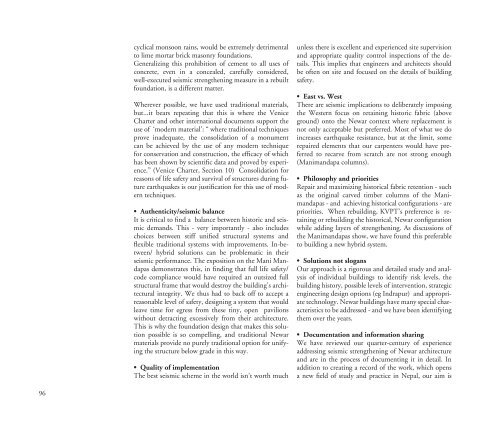KVPT’s Patan Darbar Earthquake Response Campaign - Work to Date - September 2016
You also want an ePaper? Increase the reach of your titles
YUMPU automatically turns print PDFs into web optimized ePapers that Google loves.
cyclical monsoon rains, would be extremely detrimental<br />
<strong>to</strong> lime mortar brick masonry foundations.<br />
Generalizing this prohibition of cement <strong>to</strong> all uses of<br />
concrete, even in a concealed, carefully considered,<br />
well-executed seismic strengthening measure in a rebuilt<br />
foundation, is a different matter.<br />
Wherever possible, we have used traditional materials,<br />
but...it bears repeating that this is where the Venice<br />
Charter and other international documents support the<br />
use of ‘modern material’: “ where traditional techniques<br />
prove inadequate, the consolidation of a monument<br />
can be achieved by the use of any modern technique<br />
for conservation and construction, the efficacy of which<br />
has been shown by scientific data and proved by experience.”<br />
(Venice Charter, Section 10) Consolidation for<br />
reasons of life safety and survival of structures during future<br />
earthquakes is our justification for this use of modern<br />
techniques.<br />
• Authenticity/seismic balance<br />
It is critical <strong>to</strong> find a balance between his<strong>to</strong>ric and seismic<br />
demands. This - very importantly - also includes<br />
choices between stiff unified structural systems and<br />
flexible traditional systems with improvements. In-between/<br />
hybrid solutions can be problematic in their<br />
seismic performance. The exposition on the Mani Mandapas<br />
demonstrates this, in finding that full life safety/<br />
code compliance would have required an outsized full<br />
structural frame that would destroy the building’s architectural<br />
integrity. We thus had <strong>to</strong> back off <strong>to</strong> accept a<br />
reasonable level of safety, designing a system that would<br />
leave time for egress from these tiny, open pavilions<br />
without detracting excessively from their architecture.<br />
This is why the foundation design that makes this solution<br />
possible is so compelling, and traditional Newar<br />
materials provide no purely traditional option for unifying<br />
the structure below grade in this way.<br />
• Quality of implementation<br />
The best seismic scheme in the world isn’t worth much<br />
unless there is excellent and experienced site supervision<br />
and appropriate quality control inspections of the details.<br />
This implies that engineers and architects should<br />
be often on site and focused on the details of building<br />
safety.<br />
• East vs. West<br />
There are seismic implications <strong>to</strong> deliberately imposing<br />
the Western focus on retaining his<strong>to</strong>ric fabric (above<br />
ground) on<strong>to</strong> the Newar context where replacement is<br />
not only acceptable but preferred. Most of what we do<br />
increases earthquake resistance, but at the limit, some<br />
repaired elements that our carpenters would have preferred<br />
<strong>to</strong> recarve from scratch are not strong enough<br />
(Manimandapa columns).<br />
• Philosophy and priorities<br />
Repair and maximizing his<strong>to</strong>rical fabric retention - such<br />
as the original carved timber columns of the Manimandapas<br />
- and achieving his<strong>to</strong>rical configurations - are<br />
priorities. When rebuilding, <strong>KVPT’s</strong> preference is retaining<br />
or rebuilding the his<strong>to</strong>rical, Newar configuration<br />
while adding layers of strengthening. As discussions of<br />
the Manimandapas show, we have found this preferable<br />
<strong>to</strong> building a new hybrid system.<br />
• Solutions not slogans<br />
Our approach is a rigorous and detailed study and analysis<br />
of individual buildings <strong>to</strong> identify risk levels, the<br />
building his<strong>to</strong>ry, possible levels of intervention, strategic<br />
engineering design options (eg Indrapur) and appropriate<br />
technology. Newar buildings have many special characteristics<br />
<strong>to</strong> be addressed - and we have been identifying<br />
them over the years.<br />
• Documentation and information sharing<br />
We have reviewed our quarter-century of experience<br />
addressing seismic strengthening of Newar architecture<br />
and are in the process of documenting it in detail. In<br />
addition <strong>to</strong> creating a record of the work, which opens<br />
a new field of study and practice in Nepal, our aim is<br />
96




